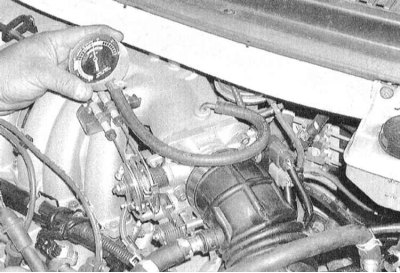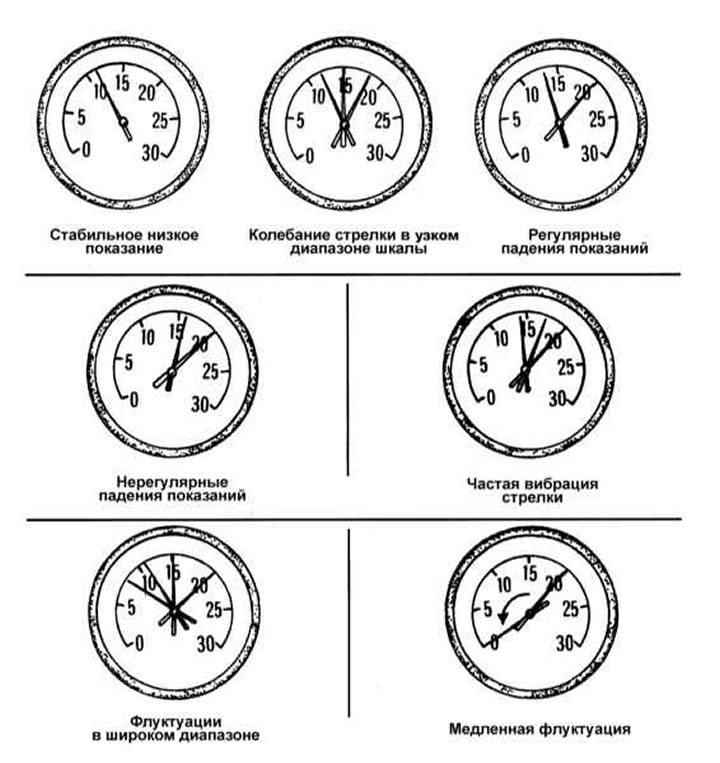Unfortunately, vacuum gauge readings are easily misinterpreted and therefore must be analyzed in conjunction with data obtained from other diagnostic tests.
When reading the indications of the vacuum gauge indicator, one should pay attention not only to the absolute value of the deviation of the arrow, but also to the speed of its movement. Most imported meters show the depth of vacuum in inches of mercury. However, it should be taken into account that all regulatory requirements are given for the case of testing at zero altitude above sea level. Every 300 m elevation above 600 m will result in a lower reading of the instrument by approximately 1 inHg. Art. Note that 1 inch = 25.4 mm.

Connect a vacuum gauge directly to the intake manifold - not to the throttle body. Make sure that all hoses remain connected during the test, otherwise the reading taken will not be considered reliable.
Warm up the engine to normal operating temperature before taking measurements. Chock the wheels and apply the parking brake. Move the transmission to position "R", start the engine and leave it running at normal idle.
Attention! Before starting the engine, carefully inspect the fan blades for cracks or other damage. Try not to bring your hands and the meter closer to the impeller. Also avoid taking a position directly in front of the car!

Read the vacuum gauge readings. On average, the depth of vacuum in the intake manifold of a healthy engine should be fairly stable (no jerky arrows) and be about 17÷22 inches (432÷560 mm) rt. Art. The following paragraphs provide a scheme for interpreting the readings taken:
Poor reading stability may indicate leaks through the gasket between the intake manifold and cylinder head, or between the manifold and throttle body. It is also possible that the tightness of the vacuum hose is broken, the ignition timing fails (backward), or violations of the installation of the gas distribution phases. Check up installation of a corner of an advancing of ignition by means of a stroboscope, then one by one exclude all other possible reasons, carrying out the checks listed in the present Chapter, only after that it makes sense to remove a cover of a GRM drive for the purpose of check of correctness of alignment of setting marks.
If the measurement result is 3 ÷ 8 inches (76 ÷ 203 mm) rt. Art. below the norm and at the same time there are fluctuations, the cause of such a deviation may be a violation of the tightness of the inlet pipe gasket in the area of the inlet port, or a malfunction of the fuel injection injector.
Regular deviation of the meter needle down from a stable reading by 2 ÷ 4 inches (51 ÷ 102 mm) rt. Art. with a high degree of probability indicates leakage of valves. Check the compression pressure in the cylinders or perform a leak test.
Irregular fluctuations or resets of readings may be associated with jammed valves or misfiring. Measure compression pressure, test for leaks, check the condition of the spark plugs.
Frequent vibration of the indicator needle within the range of 4 inches (102 mm) rt. Art. at idle speed of the engine, accompanied by a smoke emission from the exhaust pipe, indicates wear of the valve guides. Do a leak test. If the needle starts to vibrate as the engine speed increases, check for signs of leaks in the intake manifold and cylinder head gaskets. Assess the degree of valve spring sagging, check for signs of burnt valves and try to detect misfires.
Slight reading fluctuations within the one to two inch range (25 ÷ 51 mm) rt. Art. can be considered as evidence of a malfunction in the functioning of the ignition system. Verify that all normal settings are correct and, if necessary, test with an Ignition Analyzer.
If there is a wide fluctuation of the meter needle, check the compression pressure or perform a leak test to identify a defective cylinder or a leak in the cylinder head gasket.
If the meter needle with a slow speed "walks" over a wide range of the scale, check the PCV system for patency and idle mixture, also check for leaks at the carburetor/throttle body gaskets and intake manifold.
Assess the rate of return to the original value when closing the throttle after raising the engine speed to about 2500 rpm by quickly opening the throttle. The reading should first drop to near zero, then rise above normal idle by about 5 inches (130 mm) rt. Art. and return to idle speed. If the depth of depression is restored slowly and does not form a peak throw when the throttle is closed abruptly, check for worn piston rings. With a long delay in the return of readings, check the patency of the exhaust system (muffler or catalytic converter are often blocked) - the easiest way is to simply disconnect the suspect section of the exhaust system and repeat the test.